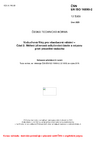Vánoční provoz a PF 2026
Vážení zákazníci,
aby bylo možné dodat objednané zboží před začátkem vánočních svátků, odešleme poslední várku zboží v tomto roce v pátek 19. prosince. Objednávky došlé po 10. hodině 19. prosince odešleme až 5. ledna 2026. Od 19. prosince do 2. ledna taktéž nebude možný osobní odběr objednaných norem.
Děkujeme za váš zájem v tomto roce,
přejeme vám hodně zdraví, pohody a úspěchů v roce 2026.
ČSN EN ISO 16890-2 (125009) Zrušená norma
Vzduchové filtry pro všeobecné větrání - Část 2: Měření účinnosti odlučování částic a odporu proti proudění vzduchu
Podívejte se na její náhradu.
Anotace obsahu normy
This document specifies the aerosol production, the test equipment and the test methods used for measuring fractional efficiency and air flow resistance of air filters for general ventilation.
It is intended to be used in conjunction with ISO 16890-1, ISO 16890-3 and ISO 16890-4.
The test method described in this document is applicable for air flow rates between 0,25 m3/s (900 m3/h, 530 ft3/min) and 1,5 m3/s (5 400 m3/h, 3 178 ft3/min), referring to a test rig with a nominal face area of 610 mm × 610 mm (24.0 inches × 24.0 inches).
This document refers to particulate air filter elements for general ventilation having an ePM1 efficiency less than or equal to 99 % and an ePM10 efficiency greater than 20 % when tested as per the procedures defined within the ISO 16890 series.
NOTE - The lower limit for this test procedure is set at a minimum ePM10 efficiency of 20 % since it is very difficult for a test filter element below this level to meet the statistical validity requirements of this procedure.
This document is not applicable to filter elements used in portable room-air cleaners.
| Označení | ČSN EN ISO 16890-2 (125009) |
|---|---|
| Katalogové číslo | 516208 |
| Cena | 590 Kč590 |
| Datum schválení | 1. 2. 2023 |
| Datum účinnosti | 1. 3. 2023 |
| Jazyk | angličtina (obsahuje pouze anglický originál) |
| Počet stran | 76 stran formátu A4 |
| EAN kód | 8596135162086 |
| Norma byla zrušena k | 1. 2. 2024 |
| a nahrazena | ČSN EN ISO 16890-2 (125009) |
| Tato norma nahradila | ČSN EN ISO 16890-2 (125009) z srpna 2018 |
| Dostupnost | skladem (tisk na počkání) |
Další příbuzné normy
ČSN EN ISO 16890-1 (125009)
Vzduchové filtry pro všeobecné větrání - Část 1: Technické specifikace, požadavky a klasifikační metody založené na účinnosti odlučování částic (ePM)
ČSN EN ISO 16890-3 (125009)
Vzduchové filtry pro všeobecné větrání - Část 3: Stanovení účinnosti metody a odporu proti proudění vzduchu pomocí hmotnosti zachyceného zkušebního prachu
ČSN EN ISO 16890-4 (125009)
Vzduchové filtry pro všeobecné větrání - Část 4: Metoda určující stanovení minimální zkušební účinnosti odlučování částic


